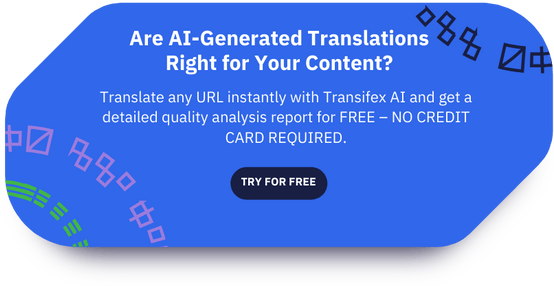It’s time to shift the perception of content creation as a separate task from globalization and market expansion.
Imagine trying to build a house with a blueprint full of errors and inconsistencies. The result would most likely be a shaky structure prone to collapse. The same principle applies to content creation aimed at international markets.
The quality of your source material is the foundation upon which your global messaging is built. If that foundation is weak, your localization and global expansion efforts will crumble.
This is the risk of not preparing your content with a global mindset. In this article, we’ll show you how to avoid these risks and optimize your source material for international audiences.
Why Source Content Quality Matters
When it comes to translation and localization, poor-quality source material leads to equally poor localized versions, no matter how advanced the translation tools or skilled the translators.
If your source content isn’t “global-ready”—clear, concise, culturally neutral, and free of errors—it will be much more difficult and expensive to adapt it effectively.
What’s more, low-quality content leads to poorly written multilingual versions that contaminate translation memories (TMs) and machine translation (MT) systems, leading to recurring issues long after the initial translation.
Global-ready content helps you prevent these errors and empowers both human and AI translators to produce even more accurate and nuanced content.
This is especially true today, as one study by Amazon AI researchers found that over 57% of all sentences on the internet have been translated into two or more languages, likely using AI-powered machine translation tools.
Think of it like this: if you feed an AI translator muddled, poorly structured, or error-ridden text, it’s going to generate a translation that’s just as messy, if not more so. Or, as some say, “garbage in, garbage out.”
AI, while incredibly powerful, can’t magically decipher ambiguous language or correct fundamental errors in logic.
The same goes for human translators, who, while more capable of dealing with poor-quality source text than their AI counterparts, still require clear, concise, and culturally appropriate content to produce accurate and effective translations.
In essence, localizing low-quality or flawed source material can often amplify issues, leading to translations that are not only inaccurate but also strain budgets due to the additional rework required, potentially damaging your globalization and marketing strategy.
The Business Impact of Low-Quality Source Content
The consequences of neglecting source content quality extend far beyond embarrassing translation errors. Consider the following:
- Increased Costs: Fixing errors after translation is significantly more expensive than addressing them at the source. Every language you translate into multiplies the cost of correcting mistakes, leading to unnecessary financial burdens.
- Damaged Brand Reputation: According to a study by CSA, 56% of online shoppers said that the ability to obtain information in their own language was more important than price. If your brand message is lost or distorted in translation, it can directly harm your bottom line and drive potential customers away.
- Missed Opportunities: If your content doesn’t resonate with international audiences due to poor translation or lack of cultural insights, you risk losing market share to competitors who have invested in high-quality localization.
- Increased Workload: Ambiguous or poorly structured source content often leads to numerous queries from translators, creating delays and additional work for both your content creators and localization teams.
Simply put, neglecting source content quality can create a snowball effect of problems that limits your ability to connect with global audiences and effectively achieve your business goals.
Creating Content For International Audiences
Crafting content that resonates across diverse cultures and languages requires a thoughtful, intentional approach.
Let’s break down the best practices implemented by global brands for writing and designing content that can be seamlessly adapted to different languages.
How to Write for a Global Audience
When it comes to writing, the devil is often in the details. Seemingly small choices in wording or phrasing can have a significant impact on how your message is received by international readers in their native language.
Clear and Consistent Terminology
A well-defined glossary of terms and a comprehensive style guide are your allies in maintaining consistency across all your content. They provide a roadmap for writers and translators, whether AI or human, ensuring that specific terms and brand voice are used uniformly throughout.
Gender-Neutral Language
Inclusivity is key when you craft your message for an international audience. Employing gender-neutral language helps avoid alienating any segment of your audience and demonstrates respect for diverse identities. For example, instead of “salesmen”, use “salespeople” to prevent gender bias and simplify translation.
Avoiding Cultural Pitfalls
Idioms, slang, pop culture references, and humor are often deeply rooted in specific cultural contexts. What might be funny or relatable in one culture could be confusing or offensive in another. Opt for clear, direct language that transcends language barriers.
For example, instead of saying “hit the ground running”, which might not make sense to a non-native English speaker, use a more straightforward phrase like “start quickly” or “begin immediately”.
Unicode for International Formatting
Use Unicode to ensure that your content can be properly displayed in different writing systems. Nowadays, UTF-8 is the most widely used encoding. This simple step prevents garbled text and formatting issues that can undermine your message’s clarity.
Designing for Global Markets
Visuals are a powerful tool in communication, but their impact can vary significantly across local cultures. Just as languages differ, so do cultural interpretations of colors, symbols, and layouts.
To create designs that resonate with global audiences, consider the following:
Flexibility is Key
Create layouts and designs that can easily adapt to different languages and scripts. This might involve using flexible grids, allowing for variable text lengths, and avoiding fixed element placements that could disrupt the flow of translated content.
Color Symbolism
Colors carry different meanings in different cultures. For example, while white often symbolizes purity in Western cultures, it can signify mourning in some Eastern cultures.
Source: coloursandmaterials.wordpress.com/2014/11/07/colour-and-cultural-design-considerations/
Research the cultural associations of colors in your target markets to avoid unintended negative connotations.
Whitespace and Visual Clarity
Leave ample white space in your designs to accommodate text expansion during translation. Some languages, like German, tend to have longer words and phrases, so ensuring adequate space prevents text from overflowing or becoming cramped.
Avoid Embedded Text
Using embedding text directly into images or graphics can make localization difficult and expensive. Instead, use separate text layers or external text files that can be easily translated and replaced.
By designing with localization in mind, you lay the groundwork for creating high-quality content for all markets and ensuring a seamless global user experience.
Pro-Tip: QA and Review Processes
Remember that saying, “Measure twice, cut once”? Well, in the context of creating global-ready content, it’s more like “review thoroughly, translate once.” The reason is simple – the worst thing you can do is waste resources translating or localizing content that’s fundamentally flawed.
Now, think of QA as your safety net, catching errors and inconsistencies before they snowball into costly problems during localization.
Here are some tips for implementing effective QA and review stages:
- Start Early: Don’t wait until the end of the content creation process to start QA. Implement checks at each stage, from initial drafting to final approval. This allows you to catch errors early on when they’re easier and cheaper to fix.
- Involve Multiple Stakeholders: Get feedback from various teams, including content creators, subject matter experts, in-country reviewers, and localization professionals. Their diverse perspectives can help identify issues that might otherwise go unnoticed.
- Use Checklists: Create checklists and establish a standard operating procedure (SOP) to crosscheck new material based on specific criteria for grammar, terminology, tone, and cultural appropriateness. This ensures consistency and makes the review process more efficient.
- Test for Readability: Assess the readability of your source text and identify complex sentences or grammatical errors using free tools like the Hemingway App or specialized ones like Transifex.
- Leverage AI-Powered Tools: AI can be a valuable ally in automating your QA efforts. Consider using specialized localization platforms like Transifex, which offer AI-powered features that streamline quality estimation and content checks at the source level and eliminate excessive manual work.
Engage International Audiences With Transifex
Transifex is the leading AI-powered globalization platform that empowers companies like Hubspot and Vodafone to accelerate growth and achieve better business outcomes.
From checking your source content to creating the final localized version and pushing it live on your site, app, or software, Transifex empowers cross-functional teams to streamline the entire localization process.
Leverage advanced AI-driven quality estimation and linguistic validation tools to ensure that your source content is optimized for international audiences. Then, simply sit back and watch as Transifex AI instantly transforms it into the languages of your target audience based on your brand’s voice, style guides, and glossaries.
Wrapping Up
Creating global-ready content is non-negotiable if you want to have an efficient and robust globalization strategy. By starting off with high-quality source material that follows the best practices for global markets or through AI-driven platforms like Transifex, you can tap into new audiences and achieve sustainable growth on a global scale.
Don’t miss out on the AI revolution in localization. Sign Up for a free trial and engage the world with Transifex AI.











